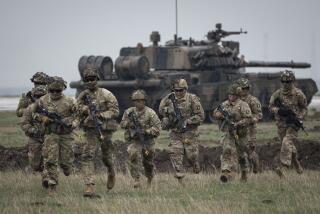Yugoslav Targets Pose Challenge for NATO
- Share via
WASHINGTON — As they consider military action to protect ethnic Albanians in Kosovo, NATO planners face a tough choice between striking at the forces of Yugoslav President Slobodan Milosevic in the separatist Serbian province or aiming at targets with greater value--but more political risk--deeper in Yugoslavia, military experts say.
The North Atlantic Treaty Organization’s leadership would prefer to limit the attacks to the southern Kosovo province, where Milosevic’s forces have driven hundreds of thousands of ethnic Albanians from their homes in a bid to suppress a rebellion by a guerrilla army, the experts say.
But potential targets in the province, where 90% of the population is ethnic Albanian, tend to be widely dispersed and have lesser military value. The targets elsewhere in Yugoslavia are more significant, the experts say.
Because of those targets’ proximity to the center of the Serbian population, however, their destruction could raise sympathies for Milosevic and dangerously strain the NATO alliance, analysts say. Strikes outside Kosovo not only could endanger large numbers of Serbian civilians but also might be viewed as a direct attack on the Yugoslav state.
“This is going to be the raging debate among the planners,” said John Hillen III, a defense specialist at the Council on Foreign Relations.
About 10,000 special police and about 10,000 Yugoslav army troops are in Kosovo, supported by tanks, artillery and other heavy equipment.
If NATO decides to go ahead with an attack, it could hit the Yugoslav army’s headquarters in Kosovo, command-and-control centers, barracks and the gasoline and ammunition dumps on which military units must rely.
But as the Yugoslav forces have pursued the separatist Kosovo Liberation Army--whose forces number fewer than 2,000--for the past eight months, they have operated in a decentralized and loosely organized manner. Because of this, they do not offer the kind of concentrated targets preferred for airstrikes.
Privately, some Pentagon officials have admitted their concern about the value of strikes in Kosovo, saying they may do little to force Milosevic to restore autonomy to the province.
But senior Clinton administration officials insist that they can hit targets within Kosovo that would cause Milosevic to pull back. And one administration official asserted Thursday that the U.S. government would support strikes outside the province if necessary.
The remainder of Yugoslavia offers “an extremely rich target environment,” said Ivo Daalder, a visiting fellow at the Brookings Institution and formerly an official with the National Security Council.
The Yugoslav army, although shrinking in recent years, was in the 1980s the fourth largest in Europe. The strikes could target its 240 combat aircraft, 60 air-defense sites and the 1,900 antiaircraft artillery that are scattered throughout the country.
U.S. officials, while offering few specifics on what kind of strikes they would favor, say they would limit them to military targets, as opposed to the bridges, electrical grid or other infrastructure that would affect civilians.
The strikes’ goal would be to “send a clear message: We have the ability to make [Milosevic] pay a price,” said a senior administration official.
Analysts say an attack would probably begin with a barrage of cruise-missile strikes to take out air-defense batteries in Kosovo, along with command-and-control centers and military headquarters.
Cruise missiles, used in August against suspected terrorist camps in Afghanistan and a plant in Sudan that allegedly manufactured a key element of a nerve gas, are best suited for hitting large, fixed targets.
After the first round of strikes, there would probably be a pause to allow Milosevic time to decide whether to pull back his forces. U.S. officials have indicated that they intend to apply a gradual escalation of force.
If he didn’t bend to NATO’s will, the alliance might follow up with strikes by aircraft aimed at knocking out more mobile military targets in Kosovo--such as groups of tanks and artillery--as well as air bases, military posts and command centers elsewhere in the country, analysts say.
More to Read
Sign up for Essential California
The most important California stories and recommendations in your inbox every morning.
You may occasionally receive promotional content from the Los Angeles Times.












